Dental Code for Pulpectomy: A Precise Guide for Optimal Tooth Health
Welcome to a succinct guide on the dental code for pulpectomy, a procedure essential for managing tooth pain and preserving dental health. In this article, we will delve into the intricacies of D3220, D3221, and D3222 codes, providing a clear understanding of each and guiding dental practitioners toward accurate coding practices.
Understanding Pulpotomy and Its Significance
Pulpotomy Explained
Pulpotomy is a dental procedure designed to alleviate tooth pain caused by cavity-induced pulp inflammation. This process involves the removal of a portion of the pulp, specifically coronal to the dentinocemental junction. The primary goal is to eliminate discomfort and restore the tooth’s shape.
D3220: Therapeutic Pulpotomy
D3220 is the specific code for therapeutic pulpotomy, excluding final restoration. Learn about the intricate details of this code, which involves the removal of pulp coronal to the dentinocemental junction and the application of medicament.
D3221: Pulpal Debridement
Explore the nuances of D3221, focusing on pulpal debridement for both primary and permanent teeth. Understand the significance of this code in ensuring optimal dental health and pain management.
D3222: Partial Pulpotomy for Apexogenesis
Delve into D3222, a code specifically for partial pulpotomy in permanent teeth with incomplete root development. Understand its role in apexogenesis and how it contributes to maintaining dental vitality.
Expert Insights on Effective Implementation
Precision in Coding for Optimal Patient Care
Discover why accurate coding, especially for procedures like pulpectomy, is crucial for effective communication between dental practitioners and insurance providers. Ensure that every detail is accounted for to streamline patient care.
Challenges and Solutions in Pulpectomy Coding
Recognize the challenges dental professionals may face in coding for pulpectomy procedures. Gain insights into overcoming these challenges, ensuring accurate documentation and reimbursement processes.
FAQs on Dental Code for Pulpectomy
Is pulpotomy the same for all teeth?
Pulpotomy may vary for different teeth based on their location and characteristics. The dental code for pulpectomy remains consistent, but specific details may differ.
How does D3220 differ from D3221?
D3220 involves therapeutic pulpotomy without final restoration, while D3221 focuses on pulpal debridement for primary and permanent teeth, providing a more detailed approach to dental health.
Is pulpectomy coding affected by patient age?
While there are no strict age restrictions, considerations may vary. Dental practitioners must adapt coding practices to suit the patient’s age and dental health requirements.
Can accurate pulpectomy coding impact insurance reimbursement?
Absolutely. Accurate coding ensures that insurance providers understand the nature of the procedure, facilitating seamless reimbursement processes for dental practices.
What recent updates have been made to pulpectomy codes?
Stay informed about the latest changes in pulpectomy coding to guarantee up-to-date practices and compliance with industry standards.
How can dental assistants contribute to accurate pulpectomy coding?
Dental assistants play a vital role in ensuring precise coding by assisting in documentation and communication processes, promoting efficiency in dental practices.
Conclusion
Mastering the dental code for pulpectomy is indispensable for dental professionals striving for excellence in patient care. Understanding D3220, D3221, an d D3222 codes ensures accurate coding, leading to optimal dental health outcomes.
Did you like this article? Read more helpful latest blogs.

